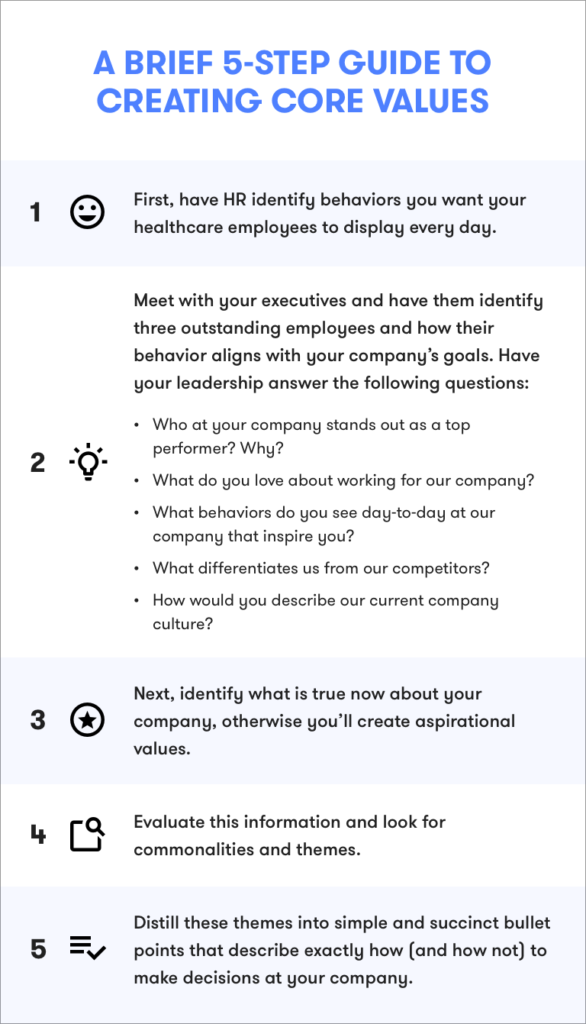
The healthcare job market is booming. In fact, the US unemployment rate decreased 0.2 percentage points to 3.5% in September 2019, the lowest it’s been since December 1969. In 2018, the healthcare industry alone added 346,000 new jobs, outpacing every other sector for job growth.
Simultaneously, hospital turnover increased by 0.9% and set a new record for the decade. While this is great news for any healthcare professional looking to expand their resume, it might strike fear into the hearts of HR leaders in the healthcare industry.

Why? Turnover in the healthcare industry is at an all-time high, which means that HR leaders are scrambling to improve retention and employee happiness at work as the demand for talent rises. Since 2014, the average hospital has turned over 87.8% of its entire workforce, and the data suggests this trend will only increase in the coming years. Average turnover in healthcare jobs is second only to the hospitality industry.
This can be a huge challenge for HR leaders in the healthcare industry — people who are already overwhelmed with the day-to-day tasks of hiring, onboarding new employees, managing payroll, and much more.
The Struggle with Burnout
Of course, struggles with turnover are intrinsically linked to employee burnout. In the healthcare industry, burnout is primarily caused by staffing shortages, and its impact only worsens over time. A staggering 70% of nurses report burnout in their current positions, and 44% of nurses worry their patient care will suffer because they’re so tired. Unfortunately, nurses are not the only members of the healthcare industry that experience burnout — rates for doctors and nurse practitioners sit around 50%.

These statistics are indicative of a crisis, the consequences of which include a decline in the quality of services, poorer patient health, an increase in mistakes made during patient care, and higher patient infection rates. In fact, there is a direct correlation between these burnout rates and patient infection rates. Even patients feel the impact of healthcare employee burnout — they report declining satisfaction rates in healthcare facilities where burnout is higher.
High Turnover and High Growth
42.3% of hospitals surveyed for the 2019 National Healthcare Retention Report anticipate an increase in their labor force, and the combination of high turnover and high growth is creating massive staffing challenges that impact a hospital’s bottom line. Hiring is one of the most expensive parts of people management processes, so these added expenses find hospitals bleeding extra cash they could otherwise dedicate to expanding programs, investing in new equipment, or even building new facilities. During a time of rapid growth, hospitals are scrambling to fulfill patient needs, hire for new positions, and replace employees who have turned over — the biggest cost of all.
The Cost of Turnover
Not only is turnover disruptive to your company, it’s also extremely expensive. Many factors come together to create the true cost of turnover. When a healthcare professional leaves their position, any given hospital must account for:
- Overtime payouts
- Hiring agency nurses
- Part-time or full-time travel nurses
- Training costs
- Increased staff workloads
- Increased accident rates
- Continuity of care
- Unplanned absences
- Medical staff dissatisfaction
The cost of replacing a registered nurse ranges from $22,000 to $64,000 a year, not including pre-hire recruitment, overtime, and losses in productivity. Even worse — nurses have some of the highest turnover rates in the healthcare industry at 14.6%. Nurses are leaving the workforce entirely to retire or change careers, with the U.S. Bureau of Labor Statistics estimating that hospitals will add an additional 203,700 new RNs each year through 2026 to fill new positions and to replace retiring nurses. By 2022, there will be an estimated 1.2 million vacancies for nursing positions.

But it’s not just nurses that have high turnover rates. The turnover trend in healthcare is rapidly accelerating: hospital turnover rates have steadily increased from 15.2% in 2016 to to 19.1% in 2019. The baby boomer generation is the largest living generation today, and as they age, they naturally encounter more health concerns.
Healthcare employees of this generation are starting to retire en-masse, which is causing high turnover rates. This shortage increases the workload for existing staff as HR leaders in healthcare scramble to fill these positions, increasing the likelihood of stress and burnout.
This is only adding to the already-existing turnover crisis costing hospitals millions. The average hospital loses $4.4M – $6.9M a year from turnover, but there is hope. As more millennials enter the workforce, they look for more than just a paycheck.
So, what can you do about it?
While these high turnover rates cost hospitals millions, there are a few ways to combat them and invite employees to invest in your hospital for the long-run.
1. Provide a Comprehensive Wellness Program
The evidence shows that healthcare employees are incredibly prone to burnout and fatigue. One way to combat this is to provide a comprehensive wellness program that enables healthcare workers to improve their health and wellbeing — inside and out.

The best wellness programs are holistic, focusing on the bodies and minds of employees. One of the most stressful parts of working in the healthcare industry is the trauma and stress employees endure on shifts. From witnessing patients struggling near the end of their lives to working long shifts with no rest, healthcare workers often fight to maintain their mental health.
Offer employee assistance programs that provide confidential support for issues like stress, substance abuse, depression, and anxiety. Free or discounted counseling is also a huge benefit for healthcare employees who need to talk through what they witness day-to-day on the job.
Often, physical health falls by the wayside for healthcare employees due to their stressful days and hectic schedules. Offering yoga classes, gym memberships, and wellness incentives can go a long way to encourage your workforce to stay healthy.
Revisiting the snacks available in your hospital can also encourage employees to eat healthier instead of taking the easy way out and grabbing a high-calorie candy bar to power through the rest of the day. Many hospitals include cafeterias that provide food for not only patients and visitors, but hospital staff as well. Consider the cost of improving the quality of your cafeteria’s food and revamping the menus to be more health-conscious.
2. Focus on Employee Experience and Engagement
Employee experience and engagement is an often-overlooked cultural element at hospitals. The facts about engagement in the healthcare industry get even more unsettling as we take a closer look:
- The healthcare industry is ranked at the bottom when it comes to employee engagement
- 44 percent of nurses worry their patient care will suffer because they’re so tired
- The engagement level of nurses has a strong impact on patient complication and mortality rates
The evidence is clear: the healthcare industry should prioritize employee experience and engagement to improve performance and retention, and protect patients as well.

The first step to engaging employees is understanding what staff wants from an employer, whether that’s financial stability, scheduling flexibility, or better benefits. Listening to employee feedback is the key way to successfully repair employee retention efforts.
One way to gather employee feedback is through conducting an engagement survey. Send this survey out to your workforce and ask questions like, “What’s the biggest thing we can do to better support our employees?” and “On a scale of 1-10, how engaged do you feel at work every day?” These in-depth questions will encourage employees to leave genuine feedback that your HR team can then use to change your hospital’s company culture for the better.
Once you’ve gathered feedback, it’s time to put it into action. There are many ways to engage employees, but the key is to recognize them for their efforts to contribute to patient care. For example, be sure to highlight and reward engaged hospital employees that:
- Make a marked effort to improve their bedside manner, taking time to ask and answer questions
- Never forget to wash their hands or check IV lines
- Escort lost family members to their destinations
- Round on the hour without fail
- Reduce mistakes when administering medications
- Listen carefully to patient concerns without rushing the conversation
- Make eye contact with all visitors
- Stay mindful of quiet hours during the night shift
- Ensure all meals are delivered hot
- Identify patients that are at risk for falling and make sure they are always escorted to and from their rooms
We’ve offered a lot of valuable reasons to recognize engaged employees for their hard work, but how exactly do you go about putting in place a formal recognition program? Let’s discuss this in detail below as we cover the third way you can address the hospital industry’s turnover crisis.
3. Establish and Reinforce Your Core Values
Rewarding and recognizing employees for being engaged is merely the first step to retaining them. The key to addressing turnover is simple: you need to build a culture at your hospital that employees can understand and live by.

If your employees come to work every day confused about how to make decisions, turnover is likely to be higher, employees are less productive, and departments are more siloed. Even worse: management is less cohesive and communicative, and teams will struggle to work together toward common goals.
The primary way to establish culture is through communicating and reinforcing core values. Healthcare employees who don’t know their hospital’s core values are more likely to leave their jobs, so it’s essential that your employees know what their day-to-day behavior should look like. The best way to reinforce your hospital’s core values is to create a culture of recognition.
Defining your company core values is essential because it provides guidance and direction — two essential components that every team needs to be efficient and functional. Below, we discuss how to identify and communicate your hospital’s core values.
Creating Your Core Values
For a complete overview on developing core values for your hospital, check out this guide. But for now, let’s briefly review the five key steps to creating your core values:

After you’ve established your core values, you need to communicate them to your employees and reinforce them every day. You can do this by rewarding and recognizing employees who embody your core values, thus signifying to the rest of your workforce that these are the behaviors that receive accolades. More on that below.
4. Reward and Recognize Key Behaviors
Employee recognition programs have the ability to reach all levels of your organization, from the cultural attributes of your hospital to the operational. These programs show appreciation for your staff, reward them for their efforts, and reinforce the core values your organization depends on to reduce turnover.

Healthcare employees who feel recognized at work are more likely to stay with their companies for longer periods of time, feel more satisfied at work, and even have patients who report higher satisfaction scores. Employee recognition is a cost-effective and impactful way to retain employees and improve the patient experience. It’s a win-win for your hospital.
You have several options when it comes to implementing a rewards and recognition program. You can do it manually, or you can implement a software to help alleviate some of the manual processes that come from managing such a program. A rewards and recognition software is the best choice for organizations as large as hospitals because it requires less time from HR leaders already managing dozens of programs.
Choose the Right Platform
So, among all the rewards and recognition options out there, what should you look for?
All successful recognition programs incorporate peer-to-peer recognition, manager-to-peer recognition, monetary rewards, non-monetary rewards, service awards, and wellness rewards. Recognition also needs to be specific, timely, and meaningful. This means you should choose a program that enables employees to send recognition instantly and include a personal message.

Millennials are now the largest working population, and Gen Y and Gen Z are following closely behind. With this in mind, your recognition program should also be mobile-driven to align with today’s technologically proficient workforce. Additionally, since healthcare employees are constantly on-the-move, recognition needs to be fast and easy.
A strategically planned and implemented rewards and recognition program doesn’t require months of effort, nor does it demand a huge portion of your budget. Building a culture of recognition at your hospital using a streamlined rewards and recognition platform is easy and high-value.
5. Transform Your Onboarding Process
The first 90 days of employment are the most critical to retaining employees, so it makes sense that onboarding is key to retaining employees. HR professionals should invest time and effort in a structured onboarding process for new employees to integrate them into the workforce quickly and efficiently. Here are three ways to transform your onboarding process and retain employees for the long-run:
Re-evaluate Your Onboarding Timeline
How long does it take to onboard your typical healthcare employee? Many HR leaders believe onboarding ends with orientation, but to actually integrate an employee into your company culture, you must provide training, education on your hospital’s history and background, an understanding of those core values we discussed above, and continuous support and feedback.

Research indicates that a healthcare employee isn’t fully onboarded until 1.5 years into the job, which is a staggering statistic considering tenure in the healthcare industry is now about 2.6 years. That’s just over one year of an employee being fully onboarded before they leave their job! With this in mind, it makes sense to integrate continuous training, education, and support in the first 1.5 years of an employee’s time at your hospital. Additionally, the first 90 days of employment is critical for retention. Be sure your new hire gets plenty of facetime with their new manager.
Start the Onboarding Process Before You Hire
Onboarding should start before an employee sets foot in your hospital on their first day of work. Have pre-planned activities that enable HR to connect with future employees, like a team meet-and-greet the week before the employee’s start date. Employees who can connect on a personal level are more likely to bond with their teammates and less likely to leave their current positions.
You can also conduct meetings before the employee’s start date to set expectations and answer questions. In this meeting, you can hand off your new hire’s schedule for the week so they know exactly what their first few days on the job look like and can plan ahead.
Offer Employee Mentorship Programs
25% of healthcare employees say that when they lack a mentor, their work is more difficult and challenging. Creating a mentorship program will decrease stress on new employees working in the high-risk healthcare environment, allowing for open dialog and continuous support. New employees (especially millennials) rely on plenty of feedback during the onboarding process, and a mentorship program can also help them align their career goals with the goals of your hospital.
Mentors can dedicate time coaching and training new employees, making sure their goals are connected to your hospital’s overall objectives — all while creating short- and long-term KPIs for employees to achieve. After all, employees who feel like they have a purpose at work and a clear path forward are more likely to stay a company for longer.
What’s next?
HR leaders in the healthcare industry have a long road ahead of them when it comes to tackling the turnover crisis, but the good news is that it’s a solvable challenge. By leveraging these five tips, you can transform your hospital from a place where staff is consistently turning over to a go-to destination where employees stay for the long haul.
 Erin Nelson is a Digital Marketing Manager at Fond with over six years of B2B SaaS marketing experience. Erin has authored dozens of articles on employee rewards and recognition and frequently researches new trends in R&R. In their spare time, you can find them playing music, reading about socioeconomic and gender-based politics, and listening to true crime podcasts.
Erin Nelson is a Digital Marketing Manager at Fond with over six years of B2B SaaS marketing experience. Erin has authored dozens of articles on employee rewards and recognition and frequently researches new trends in R&R. In their spare time, you can find them playing music, reading about socioeconomic and gender-based politics, and listening to true crime podcasts.
